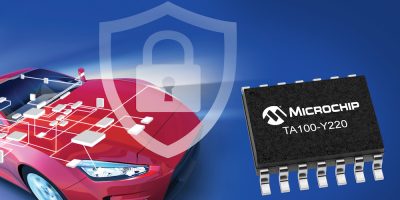Automotive OEMs and their module suppliers can use TrustAnchor to upgrade existing designs to meet security requirements, says Microchip. The cryptographic security IC supports in-vehicle network security solutions such as secure boot, firmware update and message authentication, including controller area network (CAN) MAC at bus speed, says Microchip.
The rise of in-vehicle network connections like Bluetooth and LTE/5G, means convenience but also more vulnerabilities in an automotive system. The TrustAnchor100 (TA100), CryptoAutomotive security IC helps OEMs and their module suppliers to simplify the upgrade of existing designs to meet security requirements for future generations.
To comply with new security specifications, automotive designers have to revise the vehicle’s electronic control units (ECUs) with secure hardware. Using single chip, dual core hardware security module (HSM) devices for this requires OEMs and module suppliers to rework application software to integrate the security element. This can introduce security holes, which can be overcome by third party security software but it will increase development costs.
The TA100 provides an alternative in-vehicle network architecture implementation for secure boot and message authentication. It has been approved by OEMs around the world as a solution for EVITA (e-safety vehicle intrusion protected applications) medium and full HSM requirements. Its feature set was designed following the review of OEM cybersecurity specifications. Microchip also offers security specification and request for quote (RFQ) review services to assist Tier 1s in developing educated responses.
According to Microchip, the TA100 removes the challenges associated with secure code development and provisioning by offering pre-programmed cryptographic internal application code provisioned with unique asymmetric key-pairs and associated x.509 certificates, thereby reducing risk, cost and time to market.
The device has high resistance to attack through intensive third-party vulnerability assessments, says Microchip and is AEC-Q100 Automotive Grade-1-qualified, FIPS 140-2 CMVP Security Level 2-rated and Physical Key Protection Level 3-certified. It has also achieved the highest possible vulnerability assessment rating of Joint Interpretation Library (JIL) High. The TA100 provides software components like AUTOSAR drivers, MCALs and Microchip’s CryptoAuthentication library for seamless integration into AUTOSAR, the industry standard OS, or customised software stacks for crypto functions.
The TA100 offers AUTOSAR-compliant MCAL drivers that can be integrated into an AUTOSAR software stack. A full AUTOSAR reference stack is available, enabling automotive vendors to deploy the latest crypto standards into automotive systems within standard automotive production environments, explains the company. MikroBUS-compatible socket boards are also available.
The TA100 is available in an eight- and 14-pin SOIC packages.






